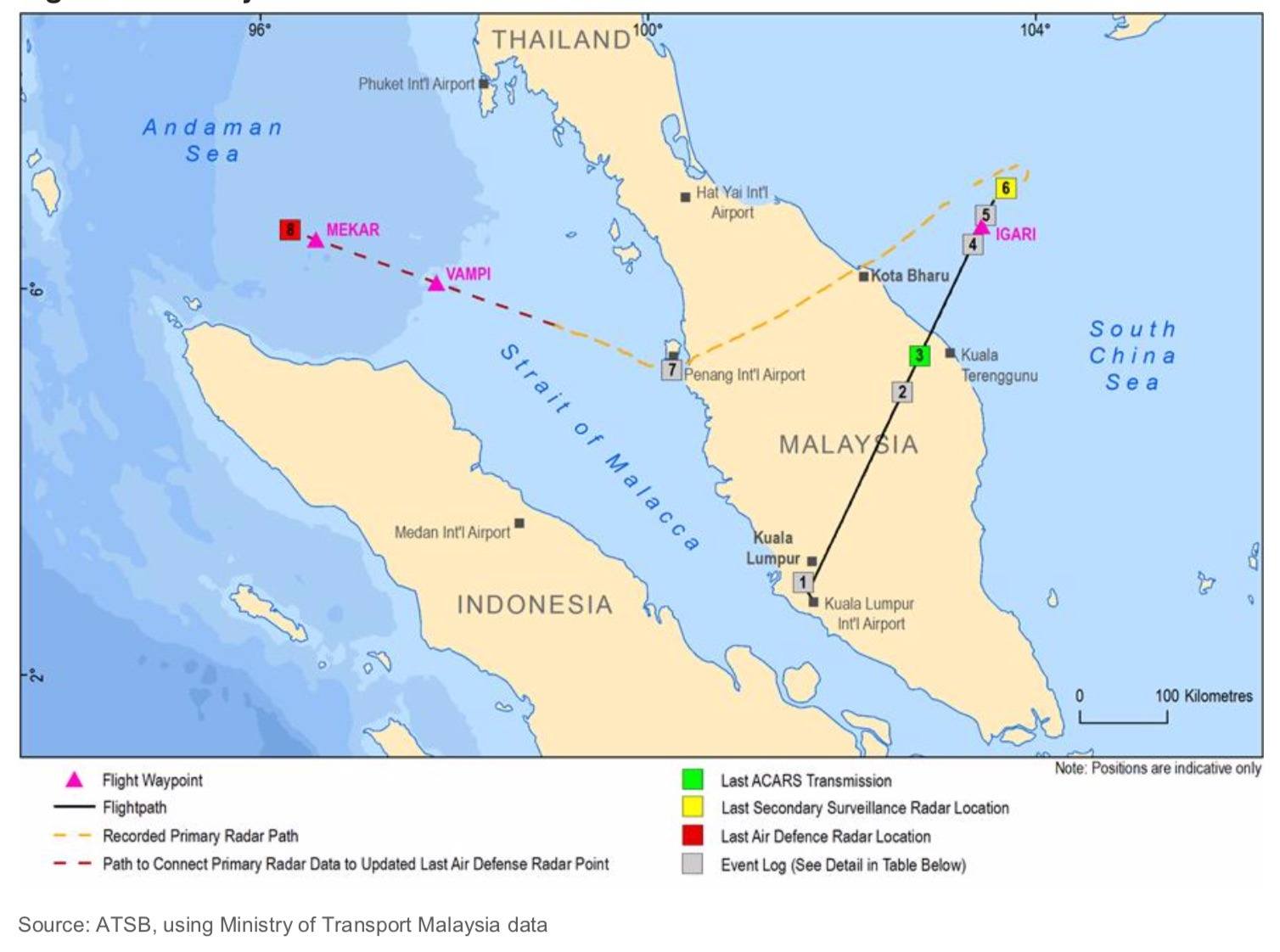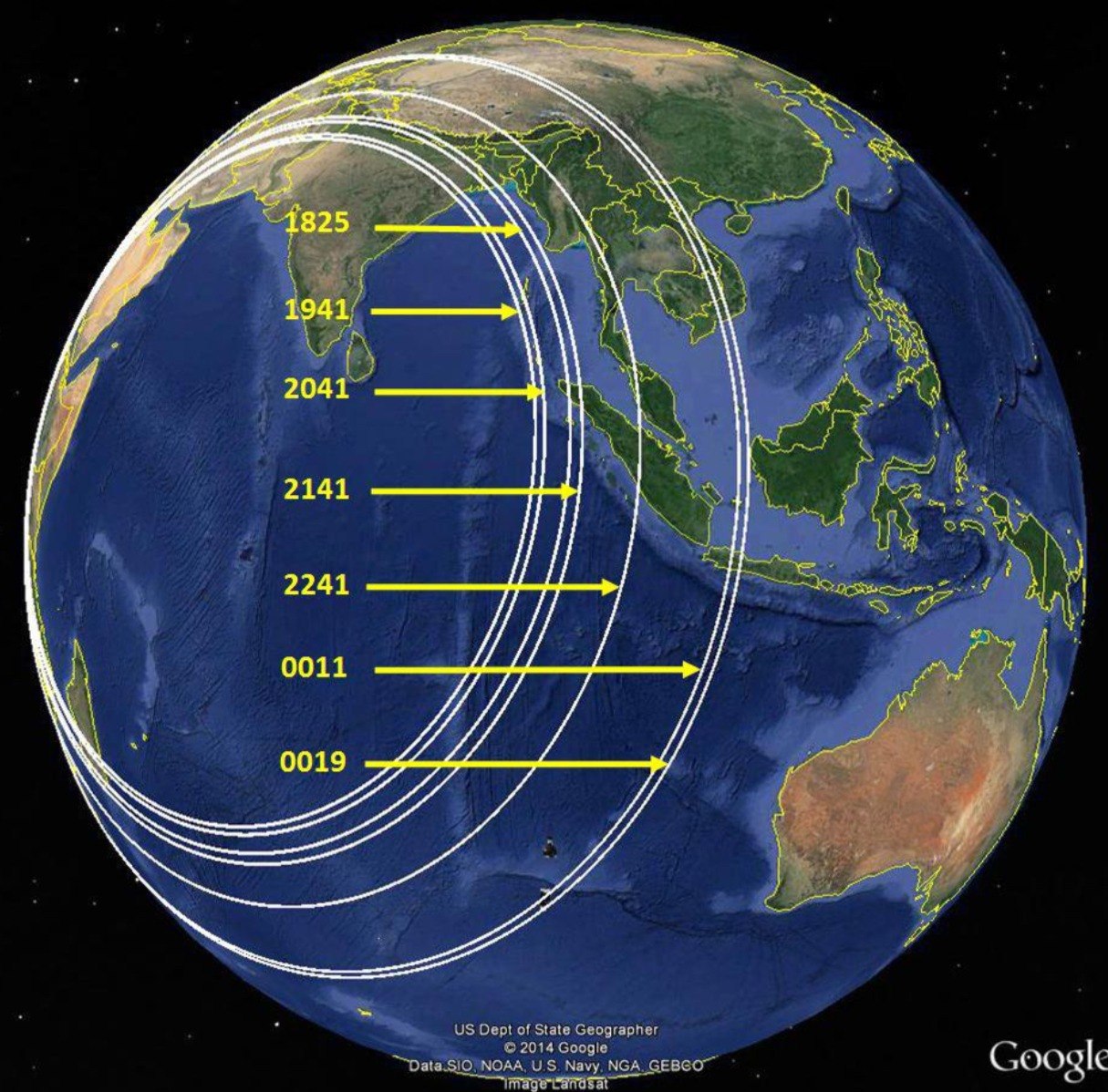by Jessica Collins
 The basic details of the story are known to almost everyone: a Malaysian Airlines flight simply disappeared one night in March 2014 and, more than five years later, the plane has still not been found.
The basic details of the story are known to almost everyone: a Malaysian Airlines flight simply disappeared one night in March 2014 and, more than five years later, the plane has still not been found.
An article by William Langewiesche in the July 2019 edition of The Atlantic revives the theory that the disappearance of Malaysian Airlines flight MH370 was a murder-suicide carried out by the pilot in command: Zaharie Ahmad Shah.
I’m not convinced, but then I’ll admit I’m not sure what to believe. I’m not an aviation expert, but I am a professional epistemologist, and it seems to me that the disappearance of flight MH370 is a fascinating practical case study in the evaluation of publicly available evidence and the assessment of rival theories. Many stories have been told about what happened to MH370, and some of them involve fairly wild conspiracy theories. Here I would simply like to weigh the pros and cons of Langewiesche’s account by comparing it to one of the other plausible competing accounts. It seems to me that there are problems facing both stories.
Let’s start with some more of the known facts.
At 12:42 a.m. on the Saturday morning of March 8 2014, Malaysian Airlines flight MH370, a Boeing 777, took off from Kuala Lumpur International Airport bound for Beijing. At 1:19 a.m., just as the plane was about to enter Vietnamese airspace, the pilot-in-charge, Captain Zaharie Ahmad Shah, signed off to Malaysian ground control with the words “Good night, Malaysian three-seven-zero”. That was the final radio transmission received from the aircraft. At 1:21 a.m. the last secondary radar signal was transmitted by the plane’s transponder, at which point the transponder either failed or was switched off.
Vietnamese air traffic control never made contact with MH370 and ongoing confusion and miscommunication between the Vietnamese and their Malaysian counterparts delayed an emergency response by several hours. The plane remained on the primary radar screens of the Malaysian military for another hour however. After making a turn back of almost 180 degrees, it crossed over the Malay peninsula again. The plane then made a slow right turn to the northwest just south of Penang Island to fly up the Malacca Strait toward the Andaman Sea. At 2:22 a.m. the aircraft went out of range of primary radar.

What we know about the rest of the flight is inferred from a series of seven “handshake” communications between the plane’s satellite data unit (SDU) and an Inmarsat satellite located over the Indian Ocean. From the “burst timing offsets” logged by Inmarsat, i.e. the lengths of time it took the signal to travel between the plane and the satellite, it was possible to calculate the distance of the plane from the satellite at the time of each handshake. This yields seven concentric circles on the Earth’s surface, and, if we eliminate those parts of the globe which the plane had insufficient time to reach, these become seven long sweeping nested arcs, each of which the plane is believed to have crossed at the time of the corresponding handshake. On the basis of that data, and some more subtle interpretation of Doppler effects recorded by Inmarsat as “burst frequency offsets”, it was inferred that the plane turned south after passing the northern tip of Sumatra and then flew on for more than six hours before finally running out of fuel and crashing in the southern Indian Ocean in the general vicinity of a point located somewhere on that seventh arc. (In the image below, the times are given as UTC, so, e.g. 1825 is 2:25 a.m. Kuala Lumpur time.)

Until now I’ve thought the most likely story about the plane’s demise was the one I discussed in my review for 3 Quarks Daily (October 3rd 2016) of Christine Negroni’s book The Crash Detectives.
Her theory may still be the most plausible.
The main obstacle to accepting Langewiesche’s account concerns the sharp, nearly 180 degree, turn back to the southwest that the aircraft made just after the final transponder communication at 1:21 a.m. The problem is that it hardly seems likely that Zaharie would have deliberately turned the plane in this particular direction if his aim was to make the aircraft disappear. That sharp turn took MH370 directly back over the Malay Peninsula and back into the overlapping views of authorities in Malaysia, Indonesia, Vietnam, and Thailand. And in fact, as we now know, MH370 was actually tracked for a while at that stage by the Malaysian Air Force, which chose, however, not to investigate or intercept the wayward aircraft.
Surely, if the goal had been to disappear as quickly and permanently as possible, then the initial turn would have been, rather, ninety degrees to the southeast and out over the open South China Sea, straight out of ground surveillance range.
Negroni’s hypothesis fits this part of the hard data much better than the murder-suicide theory does. Negroni surmises that shortly after the final cockpit communication at 1:19 a.m. (“Good night. Malaysian three-seven-zero”) the plane suffered a violent decompression event, and complete loss of electrical power, while otherwise remaining flightworthy. The pilot flying the plane immediately turned back for an emergency landing, but then quickly succumbed to hypoxia—altitude sickness brought on by lack of oxygen—and, unable to think clearly, executed several bizarre maneuvers before passing out completely, whereupon the Boeing 777 continued to fly south for many hours before running out of fuel and crashing in the South Indian Ocean.
Unlike the murder-suicide theory, Negroni’s account makes sense of that first turn back toward the Malaysian coast. In fact, the initial heading after this turn put the plane on an exact approach to the closest airport, the Sultan Ismail Petra Airport at Kota Bharu, located on the east coast of Malaysia. That would have been the obvious first choice for an emergency landing.
This point, already clear from Negroni’s book, is reiterated quite forcefully by Clive Irving in an article on Monday June 17 responding to Langewiesche on The Daily Beast website.
However, there is information reported in the Atlantic article that was new to me, and which clearly has evidential bearing too. Let’s briefly consider those three points.
First of all, there are claims that Zaharie was “lonely and sad”, in fact “clinically depressed”. To me these suggestions seem anecdotal at best, and potentially grossly unfair to Zaharie and to his surviving family.
Secondly, and more troubling to me by far, is the report that a flight simulator at Zaharie’s home was found to include a recording of a flight profile which seems to rehearse the final hours of MH370. It seems that an external hard drive connected to the flight simulator was given by Malaysian police to the FBI who then carried out the forensic investigation. The results of that investigation were leaked in July 2016 and first published in New York magazine.
Is this recovered simulator flight profile the smoking gun?
We’re told that this particular simulated flight was not played out in full over seven or eight hours, as all the other recorded profiles were, but rather was constructed sequentially in a series of discontinuous stages with estimated fuel consumption figures for the omitted sections keyed in. This might conceivably be taken as evidence for the suggestion that Independent Group engineer Victor Ianello is quoted as making, “that the purpose of the simulator flight may have been to leave a bread-crumb trail to say goodbye … ‘It’s as if he [Zaharie] was simulating a simulation’.”
One puzzle that remains in my mind is that this very idea of leaving a “bread-crumb trail” seems quite antithetical to Zaharie’s supposed goal of constructing the perfect crime: one in which an entire commercial passenger jet is made to vanish. It sounds to me like something based on an armchair theory of the stereotypical “criminal mind”. I don’t buy it.
However, you may look at the recovered data yourself. It is set out in a short paper by Ianello et al. “Captain Zaharie Shah’s Recovered Flight Simulator Information”, which is available here:
http://mh370.radiantphysics.com/papers/
What we see in Table 1 of that paper is a set of six data points recovered from use of the flight simulator on February 2 2014. It is these six data points that are supposed to constitute “a bread-crumb trail”. However, if you look at the map in Figure 1 of the paper, or simply compare the latitudes and longitudes contained in the first two rows of Table 1, you’ll see that while the first four data points are fairly close together, and the fifth and sixth are close together, the first four are distant from the final two. It seems to me that what we have here is no single trail or simulated flight at all, but rather the result of two quite separate activities carried out on the simulator on the date in question. We know that February 2 2014 was a rostered day off for Zaharie and that his next flight was scheduled for February 4, from Kuala Lumpur to Jeddah. The initial stages of that flight would proceed up the Malacca Strait roughly along a path given by the first four data points. So it seems plausible to me that this first part of that data was simply a rehearsal of the early stages of that upcoming flight to Jeddah.
My guess is that the fifth and sixth data points have nothing to do with the first four at all and that the line joining all six bread-crumbs, including the sharp turn to the south, is purely notional. Rather I suspect that Zaharie turned at some point that day from the activity of flight rehearsal to the very different task of practicing what one might do in the case of an emergency in which both engines of a Boeing 777 lost power. For this he zoomed out to map view and just chose a random spot in the middle of the ocean, then reset the simulator controls so that there was no remaining fuel. Apparently he did this twice: once practicing what to do from an altitude of 37,651 feet and once from a height of only 4,000 feet.
Now I’ll admit that this account of the flight simulator data leaves one thing unexplained: on this story it’s just a pure coincidence that the random points in the southern ocean that Zaharie picked, as though by throwing a dart at the map, just happened to be in the general vicinity of where the flight of MH370 is believed to have ended just over a month later. However, this one coincidence aside, we have what looks like a perfectly innocent explanation of what was recovered from the external hard drive.
Thirdly, and finally, Negroni’s hypoxia theory leaves one fact strikingly unexplained: a dangling coincidence of its own. The catastrophic decompression event that Negroni postulates must have coincided almost exactly with the point in MH370’s flight where the aircraft passed out of Malaysian air traffic control and into Vietnamese airspace.
The convenient timing of this initial loss of contact is another piece of hard data, but one which, this time, seems to fit much better with the murder-suicide theory than with Negroni’s story. If Zaharie wanted to make the plane vanish, then he might reasonably have expected that timing the initial break in communication to coincide with the change-of-control point was likely to create maximum confusion on the ground. Indeed, if you read Langewiesche’s article, that’s exactly what happened. Miscommunication between Vietnamese and Malaysian controllers delayed an emergency response by a full five hours!
What are we to make of all this? I don’t know. Langewiesche makes life easy for himself in the Atlantic piece by opposing his story to several wild conspiracy theories and to the straw man hypothesis of a hijacking. But it seems to me that Negroni’s account is still the main competing explanation. It’s just that any available explanation requires an implausible assumption to be made somewhere.
Whether or not Langewiesche is correct in accusing Zaharie of a monstrous crime in this case, the sad and frightening fact remains that murder-suicide by pilots is still among the greatest risks facing air travelers today.
We have SilkAir 185, deliberately crashed in 1997 by Captain Tsu Way Ming killing all 104 on board; EgyptAir 990 deliberately crashed off Long Island in 1999 by co-pilot Gameel Al-Batouti killing 217 people; Mozambique Airlines LAM470 deliberately crashed by Captain Herminio dos Santos Fernandes in 2013 killing 33 people; and GermanWings 9525 deliberately crashed in 2015 by Captain Andreas Lubitz, killing 150 people.
Langewiesche would add the 239 who died in the crash of MH370, including Captain Zaharie Ahmad Shah himself, to this awful list. I’m just not at all sure they should be.
